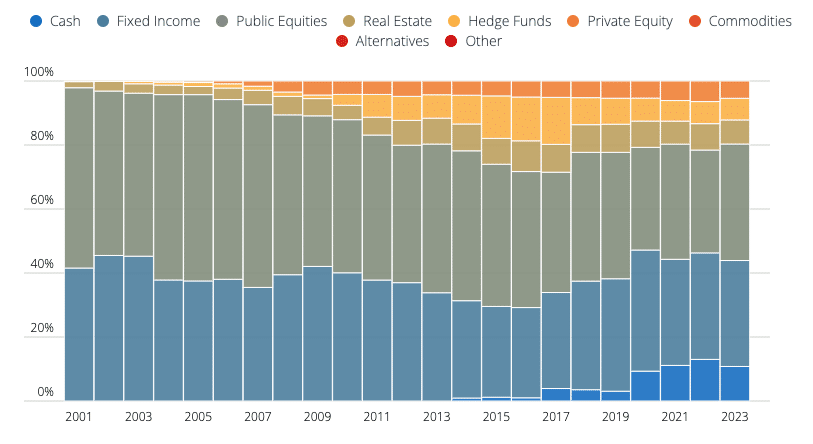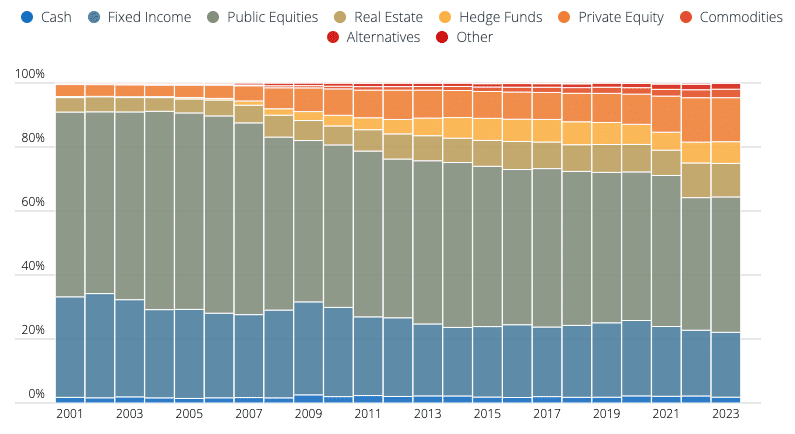Changing North Carolina’s investment strategy would bring significant risks to taxpayers, public pensions
North Carolina Treasurer Brad Briner has expressed his intent to set up a board to invest the state’s pension assets, hinting that he would like to take these funds to more risky waters by considering more “assertive” investment strategies.
While this path might generate higher investment returns, it exposes government budgets and taxpayers to additional unexpected costs if the gamble doesn’t pay off. Policymakers and taxpayers should be fully aware of these tradeoffs before shifting the way North Carolina applies market risk to the funding of constitutionally protected pension benefits promised to teachers and public workers.
Managing the investments of public pensions is a complex balancing act of achieving optimal returns while managing risk over long-term economic cycles. Government employers (and, therefore, taxpayers) are obligated to pay these pension benefits regardless of whether investment strategies play out as planned.
Many state-run pension systems have yet to recover from the significant financial losses during the 2007-2009 recession and stock market decline and continue to experience growth in unfunded pension liabilities. Despite many pension plans taking on riskier investment strategies to close these debts, public pension debt owed by state and local governments has ballooned to $1.59 trillion.
North Carolina has historically taken a more conservative approach to its pension investments when compared to the rest of the country, which is an effective way to manage potential losses and the risk of runaway costs on taxpayers. In 2008, the vast majority of pension plans in the U.S. assumed they would be able to achieve 8% annual investment returns over the long run—an assumption that has now been downgraded significantly across the board in response to underperformance.
In contrast, the North Carolina Teachers’ and State Employees’ Retirement System, TSERS, used a much lower assumed rate of return (7.25%) at that time. This practice has persisted up to today. In 2024, TSERS used a 6.5% assumption, significantly lower than the national average of around 7%.
Accompanying a more conservative investment return assumptions are conservative investment asset allocations, with a higher proportion of assets allocated to publicly traded stocks and bonds than the national average. Figure 1 shows the allocation of TSERS’ investment assets since 2001. In 2023, only 12% of its assets were allocated toward illiquid, non-publicly traded assets committed to hedge funds and private equity firms, with the other 88% allocated to publicly traded stocks and bonds.
Figure 1: Evolution of TSERS Asset Investments

Source: Annual Pension Solvency and Performance Report
This is in stark contrast to national trends (see Figure 2). In aggregate, state and locally run pension systems have kept allocation in cash very low and have significantly reduced investments in low-risk assets like fixed income (down to around 20%) in favor of expanding their investment in high-risk assets like private equity (13.8%), commodities (2.6%), and alternatives (1.8%) hoping for higher returns.
Figure 2: Evolution of National Pension Asset Investments

Source: Annual Pension Solvency and Performance Report
While most public pensions have shifted toward alternative assets, paying billions in consulting and investment fees, this strategy has yielded questionable results. A full 99% of public pensions have failed to beat the S&P 500 over the past 20 years, 60% of funds underperformed a 60/40 benchmark, and 75% of funds underperformed a risk benchmark, meaning they undertook more risk than necessary to achieve their returns.
The expected incoming fall in interest rates has fueled expectations of a more favorable market for private equity funds, reigniting interest in this asset class. Though many such funds promise double-digit returns, these investments often entail substantial management fees, long-term lockups, reduced flexibility, and a lot of risk.
Up to now, North Carolina’s approach to pension fund investing has made them an outlier compared to the rest of the country, and there is solid reasoning behind the state’s strategy. Because there is little flexibility in the pension benefits being offered to public workers, and any investment shortfall will be the sole responsibility of the taxpayer, it makes sense to operate with reduced expectations and safer investments.
The national trend of public pension systems expanding upon risky private equity and alternative investments is a byproduct of plans overextending into risk to keep up with investment return assumptions that have proven too high. This is a dangerous game that has not paid off, having made public pension plans and sponsoring governments more vulnerable to major market corrections during economic downturns. Expanding alternative asset allocation and general risk-taking would make the impact of the next recession on pensions even greater today than in 2008.
Improving pension fund returns is a worthy pursuit that can save taxpayers and their governments billions in costs, but it must be done cautiously and strategically. Rather than venturing further into an already saturated and underperforming private equity, credit, and hedge fund market, a better approach has been demonstrated to be increasing transparent passive public investments and further diversifying the asset mix, focusing on long-term growth. Such a strategy would allow the pension fund to capture market growth without the excessive costs and risks associated with high-fee, illiquid assets.
While TSERS is still $14.8 billion short of the pension benefits promised to workers, North Carolina policymakers—particularly the state’s former treasurer, Dale Folwell—took prudent steps to avoid the risky investment path chosen by many other public pensions.
What is difficult to quantify, and what policymakers must still consider, is how much risk the state has evaded by adopting a more conservative investment strategy, which could significantly impact future budgets and taxpayers if the markets do not perform as expected.
As Briner reevaluates the approach for investing TSERS’ more than $86 billion, he should do so cautiously. The rush to high-risk investments has not yielded the expected returns in many other public pensions, and it could have the same consequences in North Carolina.
While the benefits of maintaining a conservative investment strategy may not be immediately obvious, it plays a critical role in safeguarding retirees and taxpayers in the event of another economic downturn.
The post Changing North Carolina’s investment strategy would bring significant risks to taxpayers, public pensions appeared first on Reason Foundation.
Source: https://reason.org/commentary/changing-north-carolinas-investment-strategy-risks-taxpayers-public-pensions/
Anyone can join.
Anyone can contribute.
Anyone can become informed about their world.
"United We Stand" Click Here To Create Your Personal Citizen Journalist Account Today, Be Sure To Invite Your Friends.
Before It’s News® is a community of individuals who report on what’s going on around them, from all around the world. Anyone can join. Anyone can contribute. Anyone can become informed about their world. "United We Stand" Click Here To Create Your Personal Citizen Journalist Account Today, Be Sure To Invite Your Friends.
LION'S MANE PRODUCT
Try Our Lion’s Mane WHOLE MIND Nootropic Blend 60 Capsules
Mushrooms are having a moment. One fabulous fungus in particular, lion’s mane, may help improve memory, depression and anxiety symptoms. They are also an excellent source of nutrients that show promise as a therapy for dementia, and other neurodegenerative diseases. If you’re living with anxiety or depression, you may be curious about all the therapy options out there — including the natural ones.Our Lion’s Mane WHOLE MIND Nootropic Blend has been formulated to utilize the potency of Lion’s mane but also include the benefits of four other Highly Beneficial Mushrooms. Synergistically, they work together to Build your health through improving cognitive function and immunity regardless of your age. Our Nootropic not only improves your Cognitive Function and Activates your Immune System, but it benefits growth of Essential Gut Flora, further enhancing your Vitality.
Our Formula includes: Lion’s Mane Mushrooms which Increase Brain Power through nerve growth, lessen anxiety, reduce depression, and improve concentration. Its an excellent adaptogen, promotes sleep and improves immunity. Shiitake Mushrooms which Fight cancer cells and infectious disease, boost the immune system, promotes brain function, and serves as a source of B vitamins. Maitake Mushrooms which regulate blood sugar levels of diabetics, reduce hypertension and boosts the immune system. Reishi Mushrooms which Fight inflammation, liver disease, fatigue, tumor growth and cancer. They Improve skin disorders and soothes digestive problems, stomach ulcers and leaky gut syndrome. Chaga Mushrooms which have anti-aging effects, boost immune function, improve stamina and athletic performance, even act as a natural aphrodisiac, fighting diabetes and improving liver function. Try Our Lion’s Mane WHOLE MIND Nootropic Blend 60 Capsules Today. Be 100% Satisfied or Receive a Full Money Back Guarantee. Order Yours Today by Following This Link.






